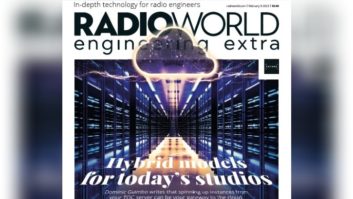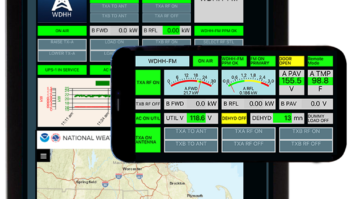Are you ready for a Digital Console?
Nov 1, 2000 12:00 PM, Chriss Scherer, editor
The technology has matured so that it is economically sensible to install a digital console – and also take a step toward the future.
When you enter an on-air studio, the first piece of equipment you probably notice is the console. It is generally at the operational center of the room. Everything centers around this one piece of equipment. This final step to a completely digital signal path is being made by more and more stations. The first digital consoles didn’t really offer any substantial improvements over their analog counterparts. This has changed. The basic function and appearance of digital consoles may replicate the analog roots, but the current functionality goes much farther.
On the surface Just looking at an analog and digital console side by side, you may be hard pressed to distinguish which is which. Both offer multiple inputs, multiple output buses and complete monitoring facilities. Digital consoles were originally designed as a replacement to the analog model. The earliest digital console entries were more expensive than the analog versions and lacked as many features. Like any maturing technology, this has since changed.
Digital consoles can be classified into one of two categories. One type functions just like its analog ancestor. It is a device unto itself. It may communicate with other pieces of equipment, but it functions on its own and does not offer any networking or routing capability. These consoles are direct replacements for analog consoles. We’ll call these the stand-alone designs.
The second variety has added some features from other equipment types. While any digital console is basically a control surface for the DSP engine behind it, this design approach to digital consoles incorporates facility-wide signal routing. All the consoles in a facility act as a network of audio sources and control signals. We’ll call this approach the network design. Stand-alone designs can be made to function like network designs by integrating them into an audio router. Also, network-design models can be configured as stand-alone designs. Deciding which method to adopt will be determined by your long-term facility installation plans. The stand-alone designs are perfect for a limited budget or one-by-one replacement. The network designs are typically implemented across an entire facility.
Most digital console designs offer the capability to assign console switches to functions other than bus assignment or channel on/off. With so much equipment providing serial or even IP control capability, digital consoles can also have the capability to communicate with these devices. Functions akin to running macros can be programmed to trigger external events.
The console control surface of a digital console acts more like a computer keyboard than a console. Some manufacturers have even taken this one step further and offer a CRT interface. These glass consoles, so named because the operator uses a touch screen or mouse to control events, have been met with some resistance so far. This type of interface offers a much greater flexibility than a physical control surface because control-surface changes can be made without changing any hardware.
Common studio setups can be saved and recalled as needed. As the morning show turns over to the midday host, the source requirements may change. Instead of requiring a console as large as a jet’s cockpit, the control-surface size can be reduced to provide as many faders as are needed at any given time.
One of the most useful features of digital consoles is enhanced integration with the on-air audio delivery system. Since audio files contain much more than just audio data, there is no reason to not use this additional data to update displays. Some consoles offer an alphanumeric display on each channel strip. This display can provide the name of the audio source (CODEC1) or even the song title that is playing.
With the coming digital transmission technology, stations are working toward creating a completely digital audio path. This digital audio path can also provide a digital data path, so the associated source information can be passed through the system. One example of this is shown in the Sirius Satellite Radio Facility Showcase on page 72. The song and artist information is passed through the facility to the listener’s radio.
To determine what console is appropriate for your facility, consider elements such as the combination of analog and digital sources in the facility and what the future needs of the facility will be. Don’t just look at the current operation. The total number of inputs and ability to add more later is also important. Look at how many outputs are available on each audio bus. What kind of mix-minus capability exists? With the audio delays encountered with codecs, on-air telephone calls and potential to feed more than one transmission medium, mix-minus capability is very important. Factors to consider for the console itself include modular construction, ease of installation, maintenance concerns (including serviceability while in use) and integration with other pieces of equipment.
Timing is everything Digital audio requires a stable clock to control the sampling frequency. Many consoles provide sample rate converters on each input so that individual sources can be connected without the need to provide a master clock reference. This is certainly convenient, but switching between sources with different clock timings can produce some unwanted clicks and pops.
If possible, multiple sample-rate conversions should be avoided. One way to do this is to provide a master clock reference to each piece of digital equipment within the facility. This clock can be a dedicated unit, or you can take a clock signal from one piece of equipment. Whatever source you choose, be sure it is accurate and dependable.
Using a facility-wide clock also necessitates selecting a standard sampling rate for the entire facility. Deciding which rate to use can be difficult. The current FM audio frequency bandwidth works well with a 32kHz sampling rate. CDs use 44.1kHz. Professional audio equipment is usually selectable, but 48kHz and 96kHz are common.
One obstacle for digital consoles has been the price. This is no longer the dilemma it once was. While most digital consoles are priced slightly higher than an analog counterpart, the cost is easily justified by the additional features and improved audio specifications.
There are many digital consoles available that are not specifically designed for on-air use. These consoles offer impressive audio performance and include powerful features. While the price tags on these consoles are attractive, most are designed for live sound or recording use. They rarely provide the additional features needed in an on-air application such as monitor muting and remote equipment starts. In most cases, modifying or adapting these consoles for on-air use offsets any cost savings.












